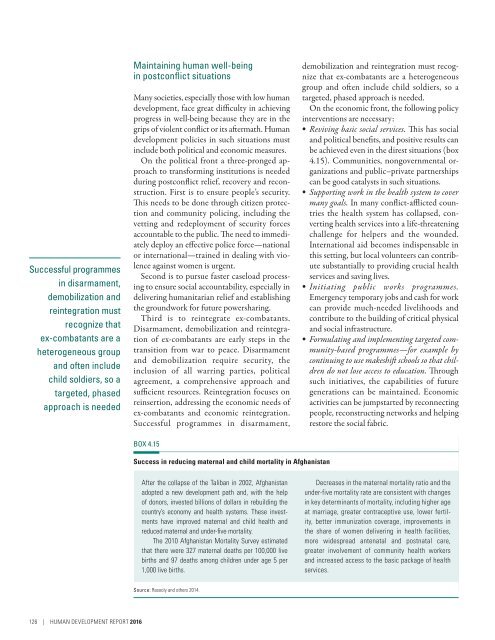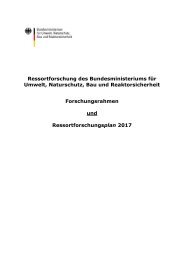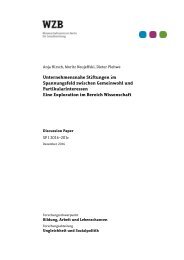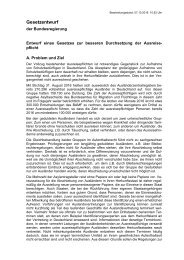Human Development Report 2016
6Tyccfrzw
6Tyccfrzw
Create successful ePaper yourself
Turn your PDF publications into a flip-book with our unique Google optimized e-Paper software.
Successful programmes<br />
in disarmament,<br />
demobilization and<br />
reintegration must<br />
recognize that<br />
ex- combatants are a<br />
heterogeneous group<br />
and often include<br />
child soldiers, so a<br />
targeted, phased<br />
approach is needed<br />
Maintaining human well-being<br />
in postconflict situations<br />
Many societies, especially those with low human<br />
development, face great difficulty in achieving<br />
progress in well-being because they are in the<br />
grips of violent conflict or its aftermath. <strong>Human</strong><br />
development policies in such situations must<br />
include both political and economic measures.<br />
On the political front a three-pronged approach<br />
to transforming institutions is needed<br />
during postconflict relief, recovery and reconstruction.<br />
First is to ensure people’s security.<br />
This needs to be done through citizen protection<br />
and community policing, including the<br />
vetting and redeployment of security forces<br />
accountable to the public. The need to immediately<br />
deploy an effective police force — national<br />
or international — trained in dealing with violence<br />
against women is urgent.<br />
Second is to pursue faster caseload processing<br />
to ensure social accountability, especially in<br />
delivering humanitarian relief and establishing<br />
the groundwork for future powersharing.<br />
Third is to reintegrate ex- combatants.<br />
Disarmament, demobilization and reintegration<br />
of ex- combatants are early steps in the<br />
transition from war to peace. Disarmament<br />
and demobilization require security, the<br />
inclusion of all warring parties, political<br />
agreement, a comprehensive approach and<br />
sufficient resources. Reintegration focuses on<br />
reinsertion, addressing the economic needs of<br />
ex- combatants and economic reintegration.<br />
Successful programmes in disarmament,<br />
demobilization and reintegration must recognize<br />
that ex- combatants are a heterogeneous<br />
group and often include child soldiers, so a<br />
targeted, phased approach is needed.<br />
On the economic front, the following policy<br />
interventions are necessary:<br />
• Reviving basic social services. This has social<br />
and political benefits, and positive results can<br />
be achieved even in the direst situations (box<br />
4.15). Communities, nongovernmental organizations<br />
and public–private partnerships<br />
can be good catalysts in such situations.<br />
• Supporting work in the health system to cover<br />
many goals. In many conflict-afflicted countries<br />
the health system has collapsed, converting<br />
health services into a life- threatening<br />
challenge for helpers and the wounded.<br />
International aid becomes indispensable in<br />
this setting, but local volunteers can contribute<br />
substantially to providing crucial health<br />
services and saving lives.<br />
• Initiating public works programmes.<br />
Emergency temporary jobs and cash for work<br />
can provide much-needed livelihoods and<br />
contribute to the building of critical physical<br />
and social infrastructure.<br />
• Formulating and implementing targeted community-based<br />
programmes — for example by<br />
continuing to use makeshift schools so that children<br />
do not lose access to education. Through<br />
such initiatives, the capabilities of future<br />
generations can be maintained. Economic<br />
activities can be jumpstarted by reconnecting<br />
people, reconstructing networks and helping<br />
restore the social fabric.<br />
BOX 4.15<br />
Success in reducing maternal and child mortality in Afghanistan<br />
After the collapse of the Taliban in 2002, Afghanistan<br />
adopted a new development path and, with the help<br />
of donors, invested billions of dollars in rebuilding the<br />
country’s economy and health systems. These investments<br />
have improved maternal and child health and<br />
reduced maternal and under-five mortality.<br />
The 2010 Afghanistan Mortality Survey estimated<br />
that there were 327 maternal deaths per 100,000 live<br />
births and 97 deaths among children under age 5 per<br />
1,000 live births.<br />
Decreases in the maternal mortality ratio and the<br />
under-five mortality rate are consistent with changes<br />
in key determinants of mortality, including higher age<br />
at marriage, greater contraceptive use, lower fertility,<br />
better immunization coverage, improvements in<br />
the share of women delivering in health facilities,<br />
more widespread antenatal and postnatal care,<br />
greater involvement of community health workers<br />
and increased access to the basic package of health<br />
services.<br />
Source: Rasooly and others 2014.<br />
126 | HUMAN DEVELOPMENT REPORT <strong>2016</strong>
















